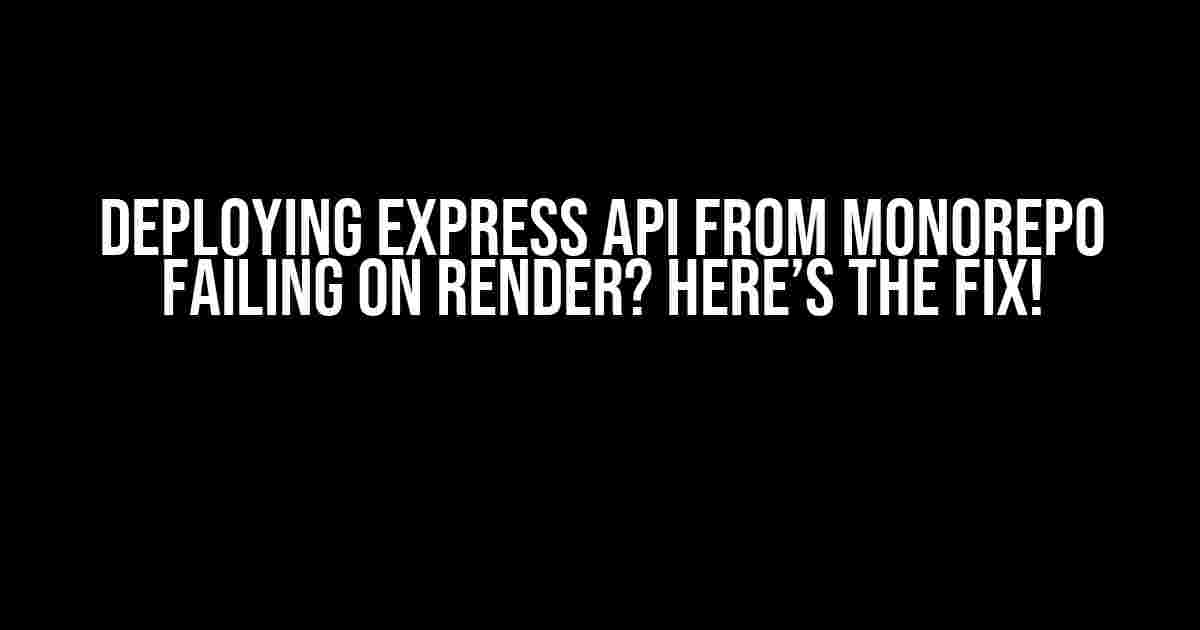Are you tired of struggling to deploy your Express API from a monorepo on Render? You’re not alone! Many developers have faced this issue, but fear not, dear reader, for we’ve got the solution right here.
What is a Monorepo?
Before we dive into the fix, let’s take a step back and understand what a monorepo is. A monorepo is a single repository that contains multiple projects or modules. This approach allows for better code organization, easier maintenance, and improved collaboration among team members.
Why Deploying an Express API from a Monorepo Fails on Render
When deploying an Express API from a monorepo on Render, you might encounter issues due to the following reasons:
- Incorrect package.json file structure: Render expects a specific package.json file structure, which can be challenging to configure when working with a monorepo.
- Inadequate build and start scripts: Your build and start scripts must be correctly configured to handle the monorepo structure.
- Missing dependencies and incorrect package versions: Make sure you have all the necessary dependencies installed, and their versions are compatible with your project.
- Inconsistent environment variables: Environment variables must be set correctly to avoid conflicts between different projects within the monorepo.
Solving the Issue: Step-by-Step Guide
Now that we’ve identified the potential causes, let’s get down to business and fix the issue! Follow these steps to deploy your Express API from a monorepo on Render:
Step 1: Organize Your Package.json File
Create a separate package.json file for each project within your monorepo, including the Express API. This will ensure that each project has its own dependencies and scripts.
// package.json (top-level)
{
"name": "my-monorepo",
"version": "1.0.0",
"scripts": {
"deploy:api": "cd api && yarn build && yarn start"
},
"workspaces": ["api", "another-project"]
}
// package.json (api project)
{
"name": "my-api",
"version": "1.0.0",
"dependencies": {
"express": "^4.17.1"
},
"scripts": {
"build": "tsc",
"start": "node dist/index.js"
}
}
Step 2: Configure Build and Start Scripts
In the top-level package.json file, create a script that navigates to the Express API project directory, builds the project, and starts the server.
"scripts": {
"deploy:api": "cd api && yarn build && yarn start"
}
In the api project’s package.json file, define the build and start scripts:
"scripts": {
"build": "tsc",
"start": "node dist/index.js"
}
Step 3: Handle Dependencies and Package Versions
Make sure to install all necessary dependencies for each project, including the Express API. Verify that the package versions are compatible with your project.
// api project
{
"dependencies": {
"express": "^4.17.1"
}
}
Step 4: Set Environment Variables
Set environment variables for each project to avoid conflicts between different projects within the monorepo.
// api project
{
"scripts": {
"start": "NODE_ENV=production node dist/index.js"
}
}
Step 5: Configure Render Settings
In your Render settings, specify the correct build and start commands:
| Setting | Value |
|---|---|
| Build Command | yarn deploy:api |
| Start Command | yarn start |
Conclusion
Deploying an Express API from a monorepo on Render can be challenging, but by following these steps, you’ll be able to overcome the obstacles and get your API up and running smoothly.
Remember to:
- Organize your package.json file structure correctly.
- Configure build and start scripts for each project.
- Manage dependencies and package versions carefully.
- Set environment variables to avoid conflicts.
- Configure Render settings correctly.
By following these best practices, you’ll be able to successfully deploy your Express API from a monorepo on Render and focus on building amazing applications!
Happy coding!
Frequently Asked Question
Having trouble deploying your Express API from a monorepo on Render? Don’t worry, we’ve got you covered! Here are some frequently asked questions to help you troubleshoot and get your deployment up and running smoothly.
What are the common reasons for deployment failures on Render?
Some common reasons for deployment failures on Render include incorrect configuration, missing dependencies, and incompatible package versions. Make sure to review your `render.yaml` file and `package.json` for any errors or inconsistencies.
How do I troubleshoot my deployment issue on Render?
To troubleshoot your deployment issue, check the Render deployment logs for any error messages or warnings. You can also try running your application locally to see if the issue is specific to the Render environment. Additionally, review the Render documentation and community forums for similar issues and solutions.
What is the difference between a monorepo and a polyrepo, and how does it affect my deployment on Render?
A monorepo is a single repository that contains multiple projects or applications, whereas a polyrepo is a collection of separate repositories, each containing a single project or application. When deploying from a monorepo on Render, make sure to specify the correct `working_directory` and `builds` configuration in your `render.yaml` file to ensure that Render builds and deploys the correct application.
How do I configure my `render.yaml` file for a monorepo deployment on Render?
To configure your `render.yaml` file for a monorepo deployment on Render, specify the `working_directory` as the path to the directory containing your Express API, and define the `builds` configuration to include the correct build command and environment variables. For example:
working_directory: ./api
builds:
- command: npm run build
environment:
- NODE_ENV: production
What are some best practices for deploying an Express API from a monorepo on Render?
Some best practices for deploying an Express API from a monorepo on Render include separating your API logic into a separate directory, using environment variables to configure your API, and defining a clear and concise `render.yaml` file. Additionally, make sure to test your API locally before deploying to Render to ensure that it works as expected.



